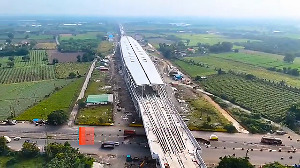The smartest homes are not the ones that dazzle with tech, but the ones that disappear into your daily life while quietly elevating it.

At exactly 6:30 am, the curtains in the master bedroom glide open halfway, just enough to let in the first golden rays of the sun -- no jarring alarms needed.
The air conditioner hums softly, having already adjusted the temperature to your preferred 22 degrees an hour before you've stirred.
As you walk into the bathroom, the lights turn on automatically, and your mirror displays the morning weather and news.
The coffee machine in the kitchen starts its slow drip. Welcome to the smart home, which knows what you need before you ask.
This is the lived reality in spaces like Gurugram's Aanandam penthouse, a smart home project by Logic Design + Build, and luxury apartments and new-age farmhouses.
These are 'homes that wake you up', and then follow your routine through the day.
"When tech is planned from day one, it declutters and adds fluidity. It's about letting design breathe while tech works silently in the background," says Anuj Kapoor, principal architect and founder, Logic Design + Build.
Want your blinds to rise halfway at sunrise? You can fix the exact percentage.
Need lights only in one section of your living area? A programmable switch remembers and delivers.
From motion-activated wardrobe lights to multi-layered security protocols, the home is today a responsive ecosystem.

From gadgets to grace
The true definition of a smart, luxurious home isn't just about loading it with devices, says Dikshu Kukreja, managing principal at CP Kukreja Architects, New Delhi.
It's about a home that responds -- to your moods, habits, and needs, he adds.
In this new vision, intelligent lighting adapts to your circadian rhythm, adjusting brightness and warmth through the day to support your biological clock.
Audio systems stream music from room to room, and all of this can be controlled from a single device -- or your voice.
But true luxury lies in invisibility. "We don't treat tech as an add-on," says Kukreja.
"It's part of the design language from the beginning. You won't see blinking panels, but you'll feel the difference."
This philosophy is echoed by Sarah Sham, founder of Mumbai-based interior design firm Essajees Atelier.
"Technology should seamlessly integrate without adding complexity," she says.
"It's not about overt displays of wealth, but the sensory experience."

Customised intelligence
Numbers indicate that those with the means and the inclination are increasingly opting for bespoke smart homes.
A Ken Research report in November last year found that India's smart homes market now stands at $6.43 billion.
'...metropolitan cities like Delhi, Mumbai, Bengaluru, and Hyderabad lead the adoption of smart home technologies,' it found.
Smart homes are being designed to learn and evolve with their residents.
From tracking their daily return time from work to adjusting lighting for relaxation or productivity, they aim to minimise effort while maximising personal comfort.
"Each switch is connected to a central system and programmable for any function, based on the person's quirks, habits, and moods," explains Kapoor.
"And some days, you just want to switch on a light manually. Analog and digital must co-exist. That's how real people live."
Rimpy Pilaannia, a Delhi-based interior designer, calls it "invisible intelligence".
People want homes that don't just respond, but understand, she says.
"From smart curtains that move in sync with sunlight to circadian lighting that changes tone and intensity through the day, homes are no longer passive spaces."
Pilaannia recounts her work on a sample apartment project, Lightswitch, where technologies like motion-sensor fixtures, concealed audio-visual systems, and ambient circadian lighting were received with enthusiasm.

The future is here
While some technologies -- like sensor-based lighting and motorised curtains -- are now almost standard, the luxury smart home is seeing rapid innovations across rooms.
Kitchens are transforming with AI-powered ovens and refrigerators that track inventory and suggest meals.
Bathrooms come with sensor-based fittings and temperature-controlled lights. And then there's entertainment: Immersive, home-theatre experiences with wire-free sound systems.
Interactive glass walls that change from transparent to opaque with a touch or sensor input, too, are becoming popular.
"This gives uninterrupted views and privacy without needing curtains," says Pilaannia.
EV charging stations are almost standard in new luxury buildings, while drone delivery landing zones and AI-assisted wellness spaces -- think meditation pods with sound and light therapy -- are gaining ground among early adopters.
"We're not far from AI-assisted kitchens and diagnostic bathrooms," says Kapoor. "These are no longer far-fetched ideas, but prototypes in high-end homes."
With growing access to advanced technologies and a robust domestic tech ecosystem, Indian luxury homes are closing the gap with markets like London, Los Angeles, and Dubai.
While Indians are today well-travelled, and expect global-level integration, "what sets India apart is our ability to merge this tech with cultural and climatic sensibilities -- inner courtyards, Vastu considerations, and materials that breathe in our environment," says Kukreja.
Kapoor adds: "Our appetite for experimentation is high. We're not afraid to blend ancient craftsmanship with cutting-edge systems."
The Indian luxury homebuyer is discerning about aesthetics. "Almost always, people want the tech to be hidden," says Pilaannia.
"Embedded charging plates, flush-mounted speakers, and clean interfaces -- everything must blend into the design."

Over-automation & cybersecurity
Despite the glamour, designing a smart luxury home isn't without hurdles.
"Timing is critical," says Pilaannia.
"Tech needs to be considered at the design brief stage -- not after construction is done. Retrofitting is expensive and messy."
Then there's the risk of over-automation. "Sometimes systems do too much," Kukreja cautions.
"We always ensure there are manual overrides. Tech should serve you, not confuse you."
Cybersecurity is another concern.
"This isn't just about gadgets; it's your entire lifestyle," says Sham.
"We use secure routers, segmented networks, encrypted access, and recommend strong passwords and regular firmware updates."
Kapoor adds that the architecture must support strong digital infrastructure: Firewalls, VPNs, local servers, and enterprise-grade routers.
"With privacy-first design, we're also exploring blockchain-based security," he says.

The price tag
While basic smart features are becoming mainstream, the level of integration seen in high-end homes comes at a premium.
Kapoor pegs the cost between ₹750 and ₹1,000 per square foot, excluding core home infrastructure like heating, ventilation, and air conditioning (HVAC), or lighting hardware.
"It depends on scale, complexity, and brand preferences," he says.
Still, for homeowners seeking a living space that not only reflects their aesthetic but also intuitively aligns with their lifestyle, the investment is more than worth it.
As Sham puts it: "A well-designed smart home doesn't shout -- it whispers, gently enhancing how you live."
And as Indian architecture moves towards a future shaped by AI butlers, gesture controls, and intelligent wellness spaces, one thing is clear: The smartest homes are not the ones that dazzle with tech, but the ones that disappear into your daily life while quietly elevating it.
Top five features
- AI climate control linked to weather forecasts
- Intelligent lighting
- Smart blinds and curtains
- Advanced security
- Predictive energy and water management dashboards
Feature Presentation: Rajesh Alva/Rediff











